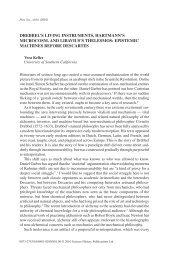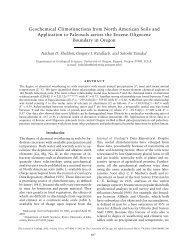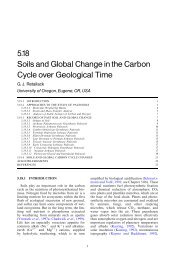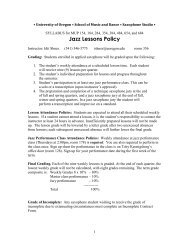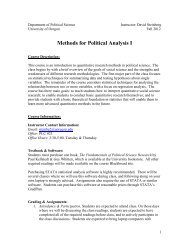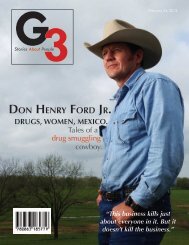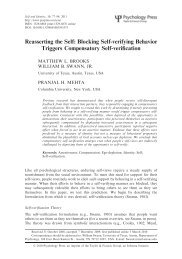12 Soils and Global Change in the Carbon Cycle over Geological Timeafter soil formation. This evidence came in partfrom petrographic studies <strong>of</strong> soil carbonate inthe paleosols, which is cut by some burrowsand cuts across other burrows (Figure 8). Thiscarbonate is a largely micritic mixture <strong>of</strong> calciteand dolomite, as is common in pedogenic carbonates(<strong>Retallack</strong>, 1985). Compelling evidencealso came from the isotopic composition <strong>of</strong>carbon in this carbonate, which was isotopicallytoo light to have formed in aquatic ormarine environments (<strong>Retallack</strong>, 2001c). Comparableburrows and tracks <strong>of</strong> millipedelikecreatures have now been reported in severalOrdovician paleosol sequences (Johnson et al.,1994; Trewin and McNamara, 1995; <strong>Retallack</strong>,2000a), but these were probably only a smallpart <strong>of</strong> the overall soil respiration <strong>of</strong> Ordovicianpaleosols. Glomalean fungi discoveredin Ordovician marine rocks <strong>of</strong> Wisconsin (Redeckeret al., 2000) were also part <strong>of</strong> an activecommunity <strong>of</strong> microbial soil respirers. Burrowsare not obvious in the Late Ordovician IronKnob paleosol <strong>of</strong> Wisconsin, but the short distance<strong>of</strong> attenuation to atmospheric values <strong>of</strong>CO 2 mole fraction and d 13 C values <strong>of</strong> carbon ingoethite <strong>of</strong> that paleosol (Figure 6) indicate soilrespiration rates comparable to those <strong>of</strong> modernsavanna grassland soils (Yapp and Poths,1994). This is remarkable, because there are noclear root traces in Ordovician paleosols, andpalynological evidence indicates no more thana cover <strong>of</strong> liverwort-like plants to feed such soilrespiration (Strother et al., 1996; Strother,2000). Primary carbon fixation by thesethin thalli with short root hairs could not havecreated a quantity <strong>of</strong> biomass or humus comparableto that <strong>of</strong> modern grasslands. Furthermore,organic-lean, red Ordovician paleosolscontain only sparse reduction spots and soilcarbonate nodules (<strong>Retallack</strong>, 1985; Driese and10 µmTetrahedraletesgrayae100 µmHypotheticalliverwort10 mmHypotheticalmillipedeBkC horizonScoyeniabeerboweri5 mmcmNo vertical exaggerationFigure 8Reconstructed ecosystem <strong>of</strong> the Late Ordovician Potters Mills paleosol from central Pennsylvania.Reproduced by permission <strong>of</strong> Palaeontological Association from <strong>Retallack</strong> (2000a).
Foreman, 1992), indicating modest carbonstorage in soil organic matter and carbonatecompared, e.g., with modern savanna grasslandsoils (de Wit, 1978). The Ordovician paleosolsstudied so far show unusually high soil respiration,considering their probable low levels <strong>of</strong>primary productivity. They also formed at atime estimated from sedimentary mass balancemodels as the steamiest greenhouse period <strong>of</strong>all Phanerozoic time, with B16 times thepresent atmospheric levels <strong>of</strong> CO 2 (Berner andKothavala, 2001). The carbon budget <strong>of</strong>known Ordovician paleosols would have contributedto this greenhouse.5.18.3.5 Terminal Ordovician IcehousePaleosolsPeriglacial paleosols, unknown in Cambrianand Early to Middle Ordovician rocks, arefound again in latest Ordovician (Hirnantian)rocks. Periglacial paleosols are best documentedin South Africa, where patterned ground andsand wedges are common in red beds <strong>of</strong> thePakhuis Formation (Daily and Cooper, 1976).The ice sheets extended over much <strong>of</strong> Africa(Ghienne, 2003).The causes <strong>of</strong> this ice age areespecially enigmatic, because volcanic activityincreased through the Ordovician and the continentswere dispersed (Bluth and Kump, 1991),thus working against cold Late Ordovicianpoles. Mass balance models make the Ordovicianice age seem particularly enigmatic, becausethey predict atmospheric CO 2 levels 16times PAL (Berner and Kothavala, 2001). Thismay be an artifact <strong>of</strong> the 10 Ma spacing <strong>of</strong> datapoints in the model, blurring the o10 Ma duration<strong>of</strong> the ice age that is indicated by carbonisotopic data (Brenchley et al., 1994). Studies <strong>of</strong>carbonate isotopic compositions from paleosolswithin the glacial interval are needed to reexaminethis question. Also needed is an examination<strong>of</strong> paleosols within this interval forevidence <strong>of</strong> fossil mosses, which would havebeen more deeply rooted than liverworts andso have accelerated weathering and carbonsequestration. Rare Late Ordovician mosslikemegafossils (Snigirevskaya et al., 1992) andspores (Nøhr-Hansen and Koppelhus, 1988)support indications from cladistic analysis(Kenrick and Crane, 1997) for a latest Ordovicianorigin <strong>of</strong> mosses.5.18.3.6 Siluro-Devonian GreenhousePaleosolsRoot traces <strong>of</strong> vascular land plants appear inSilurian paleosols, but until the Early Devonian,Record <strong>of</strong> Past Soil and Global Change 13root traces are small and shallow within thepr<strong>of</strong>iles (Figure 9b). The earliest known vascularland plants <strong>of</strong> the Middle and Late Silurianlacked true roots. Instead, they had stems thatran along the surface and just beneath the surface<strong>of</strong> the soil as runners and rhizomes furnishedwith thin unicellular root hairs (Kenrickand Crane, 1997). Plant bioturbation in soilsonly extended down to a few centimeters, butburrows <strong>of</strong> millipedes reached more deeply, andin some soils were more abundant than planttraces (<strong>Retallack</strong>, 1985). In addition to detritivorousand perhaps also herbivorous millipedes(<strong>Retallack</strong>, 2001c), Late Silurian soil faunasincluded predatory centipedes and spiderliketrigonotarbids (Jeram et al., 1990). Fungalhyphae and spores in Silurian and Devonianrocks indicate proliferation <strong>of</strong> chytrids and otherfungi (Sherwood-Pike and Gray, 1985; Taylorand Taylor, 2000).Early Devonian paleosols have abundanttraces <strong>of</strong> true roots, including woody tap roots<strong>of</strong> a variety <strong>of</strong> land plants (Elick et al., 1998).Root traces reached tens <strong>of</strong> centimeters downinto paleosols, extending greatly the depth <strong>of</strong>the active rhizosphere and its associatedmucigel <strong>of</strong> microbes. Among the numerousroots <strong>of</strong> Early and Middle Devonian paleosols,the burrows <strong>of</strong> soil fauna are less prominent(Figure 9b). Devonian soils also have higherclay content and are more deeply weathered <strong>of</strong>bases than Silurian or Ordovician soils (Figure9a). They have isotopically lighter pedogeniccarbon, closer to the isotopic composition <strong>of</strong>coexisting organic carbon, than Silurian andOrdovician paleosols (Mora et al., 1996; Moraand Driese, 1999). Within the parameters <strong>of</strong> thepedogenic carbonate palaeobarometer <strong>of</strong> Cerling(1991), these data indicate declining atmosphericlevels <strong>of</strong> CO 2 from the Silurian intothe Devonian (Figure 9c). Consumption <strong>of</strong> atmosphericCO 2 by increased hydrolytic weathering,and burial <strong>of</strong> carbon in limestone andorganic matter during the Silurian and Devonianhas been widely interpreted as an instance<strong>of</strong> atmospheric global change induced by theevolution <strong>of</strong> life (<strong>Retallack</strong>, 1997b; Berner,1997; Algeo and Scheckler, 1998).5.18.3.7 Late Devonian to Permian IcehousePaleosolsPeriglacial paleosols and glaciogene sedimentaryfacies unknown in Silurian and Earlyto Middle Devonian appear in the latestDevonian, and remain locally common inCarboniferous and Permian rocks, especiallywithin the Gondwana supercontinent, then positionednear the south pole (Figure 10; Krull,



